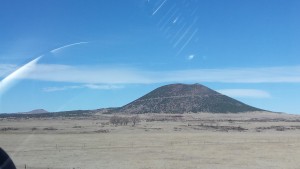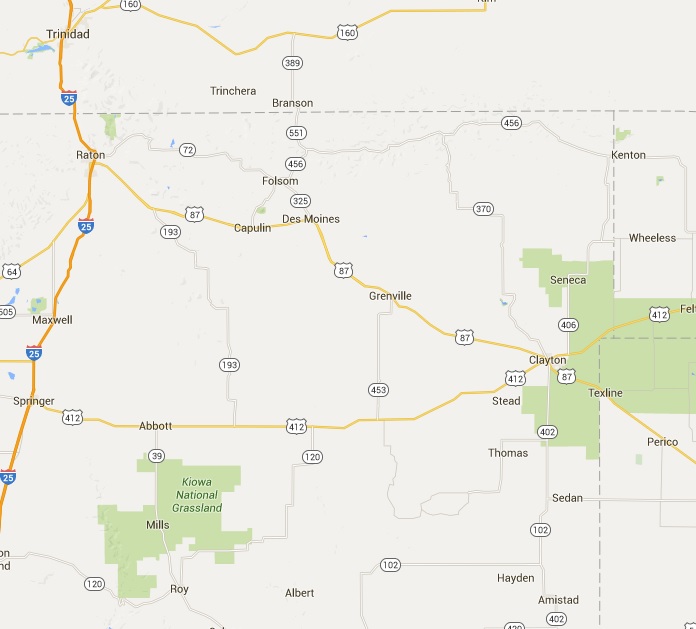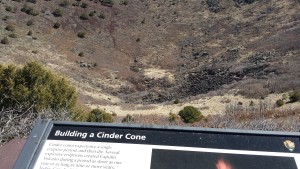Ask people to name a US volcano and you’ll get a lot of “Mount St. Helens” and “Kilauea“. The more well read types might include Mount Hood and Yellowstone.
But few people would mention Capulin in New Mexico. I didn’t know about it until last week. It’s a relatively recent (last eruption 55,000 years ago) cinder cone. It is one of the tallest and best examples of a cinder cone in the US. It’s also one of the few volcanoes you can drive up to the crater, the other two being in Oregon. It is also a national monument.

Most of the images can be clicked on to see larger (much larger).
Capulin is a part of the Raton/Clayton volcanic field, named for the two boundary towns, in north eastern New Mexico. it is located about 3 miles north of highway 87.

The area itself has a very nice visitor information center. A single road runs to a small parking lot on the low side of the crater. In my picture from hwy 87, you can see the white line running from center left to upper right. That’s the retaining wall, built so the road cut doesn’t cause excess erosion.
Taking the road to near the top allows you to look down into the crater and then take a short hike around the rim. You can also hike into the center of the crater.

There are four major lava flows from the volcano. One is pretty much each cardinal direction, covering an area of about 16 square miles. Much of the earliest flows are now cow pasture. But large masses of volcanic rock can be found in barely eroded mounds all throughout the field.
The particular volcanic rock is called scoria. It’s a very light rock formed when viscous lava contains lots of dissolved gases. It usually contains many small holes called vesicles. Basically, he rock looks like bread. Sadly, I was driving and couldn’t get a shot of the scoria piles.
To form a cinder cone volcano, scoria is ejected from the vent as small pebbles between 1/8th of an inch and about 2 inches in diameter. Over time, these small pebbles build up a mound around the vent. The collection of this rock makes for a steep sided volcano that can be pretty tall (compared to the surrounding landscape) and can form quickly.
Parícutin, in central Mexico, first erupted in a corn field in 1943. Nine years later, in 1952, it was 424 meters (almost 1400 feet) tall. It only erupted for those 9 years and is now considered extinct.
From the highway (and the top of Capulin), you can see an excellent example of a shield volcano, Sierra Grande.

Shield volcanoes are formed from low viscosity lava that spreads out in many thin layers. These volcanoes to be very flat and cover much more surface area than cinder cones.
Having both shield and cinder cone volcanoes in the same field is very unusual. Usually a volcanic field is fed by a single, large, well mixed source of magma. The Raton/Clayton field must have been fed by several magma bubbles. The volcanoes are separated in time by over a million of years.
Another very interesting feature of Capulin is that it is one of the only cinder cone volcanoes to have its own ecosystem. In general, cinder cones remain piles of volcanic rock. Capulin, however, ended up with lichens, soil, plants, over 73 species of birds and other wildlife, including large mule deer and almost a dozen species of reptiles.
Finally, while Capulin hasn’t erupted in over 55,000 years, it doesn’t mean it’s extinct. The most recent volcano in the field is called Baby Capulin and last erupted about 46,000 years ago. There’s no indication that the field is extinct, meaning that there could be an eruption again.
The eruptions in the Raton/Clayton field tend to be monogenic. The volcanoes are “born”. After a period of intense activity, that particular volcano then “dies”. It’s more likely, if this field ever erupts again, that a new volcano will be created. I guess that’s why there’s a 20 mile “Safety Zone” around Capulin.
If you are in the area, go take a look. It won’t take long and it’s really pretty cool.
